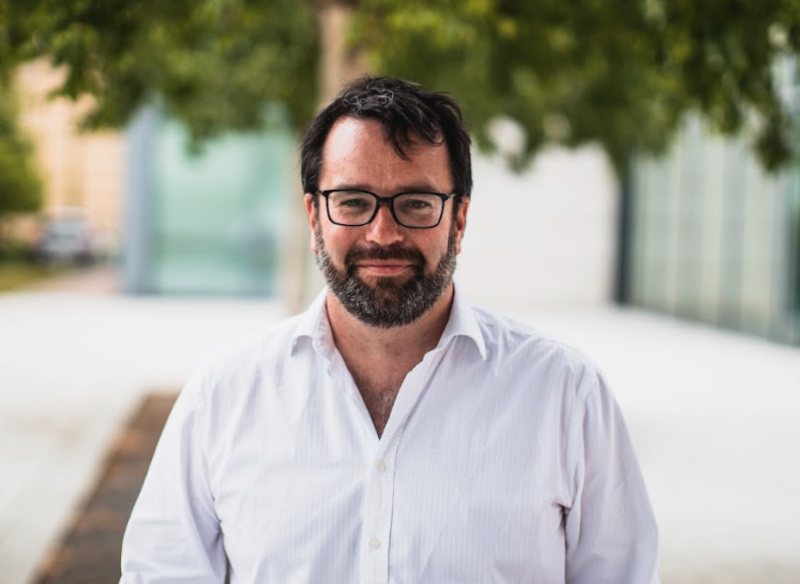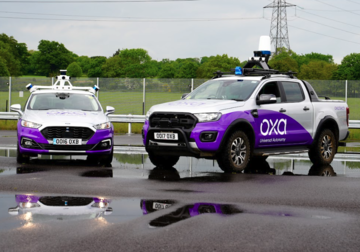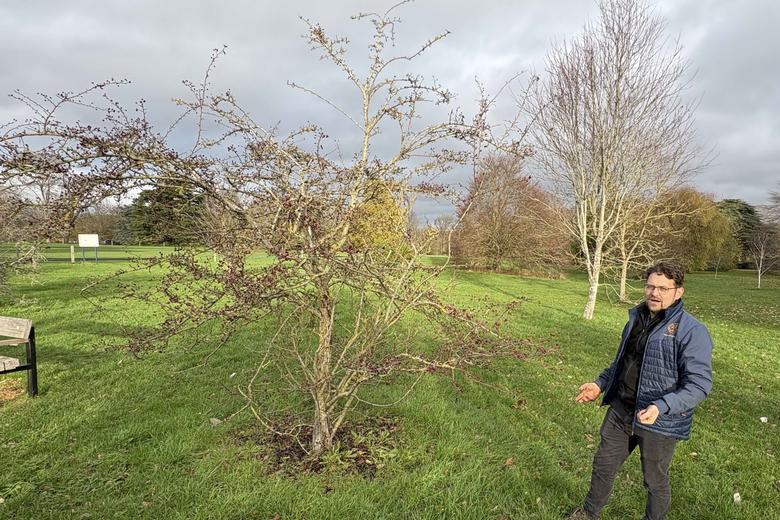OXA IN THE DRIVING SEAT

OXA IN THE DRIVING SEAT
Newly honoured Paul Newman’s Oxford company Oxa is a rapidly growing global force in autonomous driving
Published: 4 July 2023
Author: Richard Lofthouse
Share this article
Like the University, like the company: Oxa, formerly Oxbotica, has changed beyond recognition in recent years yet retains a collegial civility that other companies would do well to match, plus a ravenous eye on global growth as it ‘scales’, to use the industry jargon.
Principal Engineer Colin McManus (LMH, 2011) heads Oxa’s core software product and has been at the company since the beginning.
His LinkedIn profile states unambiguously: ‘Actively Hiring’, and the company website shows over 15 vacant positions, a rare instance of growth at a moment when many of the recent headlines about self-driving cars have concerned lay-offs and closures.
To explain this apparent paradox is to dig to the base of what makes Oxa so special and so unusual.
But first the stunning headline that Oxa, rebranded from Oxbotica on 30 May, is the toast of the UK innovation community in 2023, having recently snaffled $140 million in a Series C funding round despite an otherwise lack lustre investor environment for deep tech.
To be clear that’s $140 million for a company with 350 employees, mostly based in Oxford but with satellite teams in Toronto, Canada and Colorado, US.
No surprise that Oxa founder Professor Paul Newman (Balliol, 1991) was just appointed Commander of the British Empire (CBE) for services to engineering and technology in the 2023 King’s Birthday Honours. He is also the CTO for the company and recently became President, the CEO role belonging to Gavin Jackson.

The funding success is an extraordinary testimony to Paul’s original vision, when he founded the company with co-founder Ingmar Posner, in 2014 (Ingmar is a Professor of Engineering Science at Oxford, specialising in applied artificial intelligence).
That vision was always anchored in reality, while still being visionary – a very difficult balance to strike in a sector notorious for hype.
Paul initially left Oxford to work in Sydney, Australia, and then at MIT in Boston. He then returned to Oxford as a young academic.
‘I was insatiable and delighted. I was surrounded by greats. I could make something unreasonable here. Oxford felt like a ‘yes kind of place.’
Perhaps the best way of stating the Oxa vision is via one of its early institutional investors, cleantech venture capitalist company Kiko Ventures.
‘At Kiko Ventures we decided early on that autonomous vehicle software offered huge potential, but we envisaged different applications to most investors. Instead of self-driving cars taking us around town, we believe autonomy will initially be deployed in, for example, goods delivery, safety-critical industrial environments and multi-occupancy on-demand urban shuttles.’
Bryn Balcombe, responsible for Autonomy Systems and Regulations at Oxa since February 2022, says ‘I have always respected the very realistic stance of Oxa regarding what’s possible, and by when, in this sphere.’
If that’s praise for Oxa, it is also a measuring stick for what’s recently gone ‘wrong’ in the world of self-driving cars, although anyone working around experimental technology will say that ‘wrong’ is a bit blunt, it’s rather that the road to autonomous vehicles was inevitably more twisty than initially thought.
McManus recalls all the excitement of a previous trial from about six years ago in the pre-COVID mists of time, where an autonomous shuttle bus pod shown off to journalists.
‘It was so exciting to the media that Sky News sent a helicopter to cover it.’
Bryn, cites the brutal ‘end’ of what he calls a ‘five-year hype cycle in the western media about robotaxis’.
Only last October US car maker Ford and German car maker Volkswagen wrote off $3.6 billion on self-driving entity Argo, closing it completely but quietly absorbing some of the employees.
The view now is that it will take longer than expected to attain ‘Level 4’ autonomy, defined by the Society of Automotive Engineers as ‘full driverless capability in controlled areas.’
Since 2014, Oxa has instead worked steadfastly and quickly towards what the company calls ‘universal autonomy’, a software stack that can be applied to numerous industries in different ways to enable the autonomous operation of vehicles.
McManus remembers meeting Paul and getting the elevator pitch – the idea was not to pursue a robotaxi, the tech equivalent in 2014 of aiming to climb to the summit of Mt Everest having never learned to walk.
At the time, McManus recalls being ‘a little bit anxious.’
‘There was a risk that by building a platform agnostic architecture, that in some sense we would be left behind.’
But viewed now from 2023, the robotaxi vision deferred, he says that Oxa is now in the driving seat of a technology whose first real fruits are just starting to be tasted.
Take the airport parking bus for example. It runs around an unvarying loop, day and night, at low speeds, in a highly controlled environment. One of Oxa’s commercial partners in Germany will launch a service by the end of 2024.
The less obvious but potentially juicier fruit lies in the broader autonomy sector and light industrial applications such as warehousing and logistics, and heavier applications such as mining and forestry, many of these ‘off-highway’ applications where the applicable legislation is more likely a health and safety ruling than a highways protocol.
Another Oxford alumnus at Oxa, Aamir Aziz (New College, 2007), currently Principal Product Engineer but originally a graduate of Oxford’s ultra-esteemed Engineering, Economics and Management degree, says that the actual technology is now largely proven and the other players in this space have stopped boasting about the number of miles that have been driven by their unmanned fleet.
‘Instead,’ he says, ‘we’re now at the point where it’s a case of developing bespoke applications for our partners.’
That includes the autonomous bus service with German partner ZF Friedrichshafen and on-road vehicle networks by Madrid, Berlin and Paris company Goggo Network.
But the example that comes up the most in discussion is oil major BP, in respect of petroleum refineries and solar and wind energy sites where there is apparently huge potential for unmanned vehicles.
Another Oxa customer is Canadian Mining technology provider Wenco International Mining Systems.
Bryn is the first to note that the mining sector is no stranger to autonomy having deployed certain applications for over twenty years.
But he also uses the sector to illustrate a deeply revolutionary point about the ultimate potential for autonomous vehicles.
‘The largest mining truck can carry 400 tonnes of rock. The reason it is so vast is because that level of scale is required to make economic sense of having a driver present.’
Instead, he suggests, it may be cheaper in the future to have ten such trucks, each of them cheaper and sleeker with no cabin, deployed autonomously on a 24/7 basis and managed from a city hundreds of miles distant from the mine itself which is invariably a remote and expensive location in which to base employees. The average real cost of fielding one mine truck driver per year is estimated at $200,000, so more autonomy in this sector is highly desirable.
Oxa Lead Robotics Engineer Stephen Kyberd (Brasenose, 2010) raises a parallel example of agriculture, where there is currently vast innovation in the area of autonomous picking machinery at a moment when there is a chronic shortage of both manual labour and drivers across Europe, projected to triple to 2 million by 2026.
‘Until now every generation of tractor has been bigger and heavier to achieve scale efficiency, but often at the price of, say, damaged soil from its sheer weight, and high operating costs.’
‘But we’re now at an inflection point where smaller, lighter, cab-less, autonomous tractors and other robotic devices might offer a very different future.’
If we turn to the on-highway heavy freight sector, there have been hot arguments in the public domain very recently about whether batteries are ever going to work as the drivetrain for large trucks, on account of their present limits of weight and performance.
Once again, the reason why trucks are heavy to begin with is partly due to the necessary operating efficiency required to merit a human driver.
Autonomous technology has the potential to fragment the ‘bigger/heavier is better/more efficient model’, so that potentially smaller vehicles with reduced payloads are nonetheless more efficient because of the way that they might travel more often with an optimised load, exploiting other opportunities in the so-called ‘middle’ and ‘last’ mile of delivery, where electrification is very much on the cards.
For long distance heavy freight, we might be looking at a hybrid model where a hydrogen- or gas-fuelled truck self-drives known sections of motorway, and a human operator manages the rest.
Of course, none of this means that autonomous self-driving cars have gone away or are impossible to envisage. The robotaxi model is still being trialled in China and in North America, and it is even available to consumers in some limited applications.

But Oxa again brings us back to reality. It scored a landmark last May with Europe’s first Autonomous Vehicle insurance policy, permitting their own self-driving car to scoot around Oxford, completely unmanned (shown, right).
The hardware is not to be confused with the software. The vehicles will be built by others and the lidar, a sophisticated type of radar, will also be sourced from suppliers. What the Oxa software does is make sense of the data from the hardware, providing a many-layered visibility of what the vehicle’s systems have ‘seen’ and how it has ‘made sense’ of them. This transparency is critical to safety and thus insurance liability.
That matters so much here because Oxa finds itself a software company at a moment of convergence with the automotive and wider transport sector, where a car is rapidly being reconceived as a ‘software defined product.’
French car maker Renault is working with Qualcomm and Google on ‘CAR OS’, meaning ‘Operating System’, while Oxa’s German partner ZF Friedrichshafen is working on its own software stack called Cubix.
Parallel developments are everywhere whether Asia or North America, with China very much at the forefront through providers such as Baidu-Apollo and Auto-X.
McManus says he dreams of every car driven by the company’s software being labelled, Driven by Oxa, echoing the commercial tag Powered by Intel. It’s not difficult to see why the company rebranded from four-syllable ‘Oxbotica’ to two-syllable ‘Oxa’ on 30 May.
It might not satisfy petrol-heads but there are other silvery linings down the road, even as trade union groups cry foul over the suspicion that autonomous tech is primarily to reduce the wage bill of drivers.
Laine Clark Balzan (St Hugh’s, 2006), currently a senior software engineer for Oxa, notes, ‘I have aging family in the US, and in Tennessee where they live you really have to drive to be connected.’
Self-driving cars and autonomous hail-to-ride bus pods, will be a boon to the elderly in communities where currently transport links are poor – and that includes Oxford to the extent that so many bus routes have been reduced or shut in recent years, another use-case that cropped up in the interviews conducted for this feature.
Newman says, ‘as the UK makes good on its potential and promise to be an AI super power no surprise that we are using AI to change how the earth’s population moves. As an engineer the attributes of self-driven technology are irresistible - not only does it offer genuine transformation to a society that currently moves things in stupid, unsafe, polluting, expensive and clumsy ways, but it is also intellectual cat-nip. Building composite robotics and AI systems that are trusted, auditable, performant, explainable at scale and at speed. Wow, it doesn't get any better….’
Whether in the commercial space or the community space, autonomous vehicles will one day be ubiquitous, and there’s a strong chance that a goodly portion of them will be operated using software that originally developed at University of Oxford.
In the King’s Birthday Honours 2023, Professors Paul Newman and Alison Noble, both of Oxford’s Department of Engineering Science, were both appointed Commanders of the British Empire (CBE) for services to engineering and technology, and engineering and biomedical imaging respectively. Other Oxford post-holder recipients are noted HERE.















